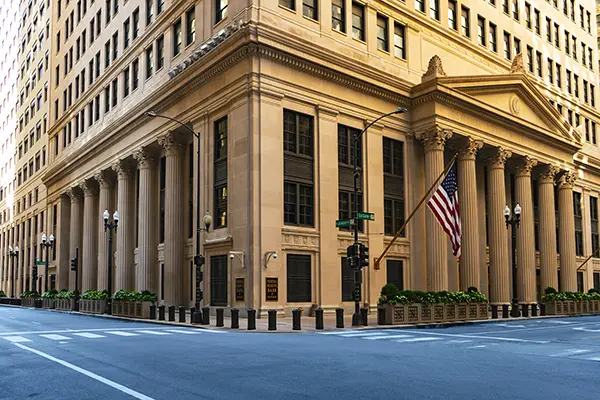Fixed Interest
Morgans offers an extensive range of Fixed Interest products and services to help you achieve your investment objectives. Your adviser will help you incorporate fixed interest into your broader wealth management strategy.

Invest for income
Cash management accounts

Cash management accounts
Enjoy the convenience of our at-call cash facilities with competitive interest rates. Our preferred products offer direct bank deposits in your name with reputable Australian banks, providing easy access to your funds. Link your account to your share trading account for seamless settlements and have dividends and interest payments deposited directly. Your adviser will manage paperwork and transactional instructions, relieving you of administrative tasks.

Term deposits
Enhance your returns and build an income portfolio with our term deposit options. Held at reputable financial institutions, term deposits offer fixed terms and higher interest rates compared to at-call accounts. You can benefit from our preferential relationships with leading banks and Authorised Deposit-taking Institutions (ADIs) to find the best term and interest rate for your needs.
Morgans provides foreign currency term deposits with attractive rates for deposits exceeding AU$100,000, and flexible/structured term deposits, allowing you to combine floating and fixed interest rate payments based on your outlook on future interest rate levels.

Listed debt and hybrids
As a major participant in the Australian listed fixed interest securities market, we can offer you advice as well as a range of new investment opportunities from a range of Australia's largest banks and industrial companies.
Listed debt and hybrid investments deliver higher levels of income, paid regularly; some also offer the benefits of franking. Your adviser can build a tailored income portfolio for you, which unlike managed fund alternatives, can be constructed to take into account your specific objectives and risk profile.

Government and corporate bonds
A government bond is a debt obligation of the issuing government, signifying that when you invest in a government bond, you are essentially lending money to the issuing government. As a debt obligation, the issuer is obligated to make all contracted payments. Bonds, being wholesale debt securities, are traded by institutional investors and are not subject to a prospectus.
We offer a comprehensive Government bond investment service, including custody facilities. Bonds improve portfolio diversification and help reduce portfolio risk while providing stable income.

Exchange-traded Government bonds
Exchange-traded bonds on the ASX provide holders with access to bonds issued by the Australian Government providing a low-risk security and diversification for investment portfolios.

News & insights
Australia’s households could face higher electricity costs and rising inflation in 2025. With electricity subsidies ending and energy supply constraints persisting, the Reserve Bank of Australia (RBA) may be forced to lift interest rates. Here’s what you need to know.
Key Summaries
- Retail electricity subsidies worth $9 billion per year are being phased out.
- Retail electricity prices are expected to rise sharply in 2025.
- Inflation could accelerate to 4% or more in the second half of the year.
- RBA may then need to make three 25-basis-point rate hikes.
- The cost of renewable energy is not just the cost of wind and solar,
natural gas is also needed to stabilise renewable energy.
Why Are Electricity Prices Rising?
The government’s decision to remove $9 billion in electricity subsidies will expose households to the true cost of power. Over the past two years, wholesale electricity generation costs have surged by 23%, driven by supply constraints and reduced capacity in New South Wales.
How Will This Impact Inflation?
Electricity prices feed directly into the Consumer Price Index (CPI) with a lag of around two quarters. As subsidies end, retail prices will rise, pushing inflation higher, especially in the second half of 2025. Businesses will face increased costs and pass these on to consumers.
Interest Rates: RBA’s Likely Response
Higher inflation means the RBA will need to act. While some banks forecast small rate hikes early in the year, Morgans expects three 25-basis-point increases in the second half of 2025. This could significantly impact mortgage holders and borrowing costs.
The Role of Renewable Energy and Gas Pricing
Despite claims that renewables are the cheapest energy source, electricity prices remain high because consumers need power 100% of the time. The marginal cost of electricity is set by natural gas, which stabilises supply when renewables cannot meet demand. Global gas prices, influenced by events such as the war in Ukraine, ultimately determine the cost of electricity in Australia.
FAQs
Why are electricity prices increasing in Australia?
Because subsidies are ending and generation costs have risen by 23% over the last two years.
How will this affect inflation?
Consumer prices could rise by 4% in the second half of 2025 as higher energy costs flow through the economy.
Will interest rates go up?
Yes, the RBA may raise rates three times in the second half of 2025 to curb inflation.
Are renewables making electricity cheaper?
Not necessarily. Prices are influenced by natural gas, which sets the marginal cost of supply.
What does this mean for households?
Expect higher power bills and increased mortgage costs if rates rise.
Australia faces a challenging year ahead with rising electricity costs, accelerating inflation, and likely interest rate hikes. Planning ahead is essential for households and investors.
Want to discuss how this impacts your portfolio?
DISCLAIMER: Information is of a general nature only. Before making any financial decisions, you should consult with an experienced professional to obtain advice specific to your circumstances.
Federal Reserve Interest Rate Outlook: What Investors Need to Know
The Federal Reserve’s latest projections reveal a surprisingly moderate outlook for inflation and interest rates. Despite tariff concerns earlier this year, the Fed expects inflation to remain subdued and rates to decline gradually. Here’s what this means for markets and investors.
Key Takeaways
- Fed forecasts interest rates around 3.4%, aligning with market expectations.
- Inflation impact from tariffs is far lower than predicted.
- Core inflation expected to fall to 2.5% next year and reach target levels by 2028.
- Growth outlook remains positive with no recession in sight.
- A benign economic environment could support U.S. equities.
What the Fed’s Latest Projections Tell Us
Every quarter, the Federal Reserve releases its Summary of Economic Projections (SEP), which includes forecasts from the Federal Open Market Committee and regional Fed banks. These projections carry significant weight because they reflect the collective view of some of the most influential economists in the U.S.
Table 1. Economic projections of Federal Reserve Board members and Federal Reserve Bank presidents, under their individual assumptions of projected appropriate monetary policy, December 2025

Interest Rate Outlook: Gradual Declines Ahead
Our model estimated the equilibrium Fed funds rate at 3.35%, and the Fed’s own forecast is close at 3.4%. This suggests rate cuts are likely in the near term, with further declines to 3.1% in subsequent years. For investors, this signals a stable environment for borrowing and equity markets.
Inflation: Lower Than Expected Despite Tariffs
Earlier predictions suggested tariffs could push inflation up by 1.6%, but the actual impact has been minimal. Headline inflation is projected at 2.9%, and core inflation at 3%, well below initial fears. The Fed expects core inflation to fall to 2.5% next year, then to 2% over the longer term.
Growth Outlook: No Recession on the Horizon
Despite global uncertainties, the Fed anticipates steady growth: 1.7% this year, 2.3% next year, and 2% thereafter. This benign outlook, combined with easing inflation, suggests a supportive environment for U.S. equities.
FAQs
Q1: Why is the Fed cutting rates?
To maintain economic stability and support growth amid moderating inflation.
Q2: How will lower rates affect investors?
Lower rates typically reduce borrowing costs and can boost equity markets.
Q3: Are tariffs still a risk for inflation?
Current data shows tariffs had a smaller impact than expected, thanks to strong service-sector productivity.
Q4: Is a U.S. recession likely?
The Fed’s projections show no signs of recession in the near term.
Q5: What is the Fed’s inflation target?
The Fed aims for 2% core inflation, which it expects to achieve within a few years.
The Federal Reserve’s outlook points to a stable economic environment with easing inflation and gradual rate cuts. For investors, this could mean continued opportunities in equities and fixed income. Want to learn more about how these trends affect your portfolio?
Investment Watch is a quarterly publication produced by Morgans that delves into key insights for equity and economic strategy.
This publication covers
Economics - 'The Australian economy: a landscape of challenge and opportunity'
Asset Allocation - 'Structural shifts demand a portfolio rethink'
Equity Strategy - 'Diversification is key'
Banks - 'Fundamentals don't justify share price strength'
Industrials - 'Prepared for the uptick'
Travel - 'Selective opportunities'
Resources and Energy - 'Steady China and tight supply'
Consumer discretionary - 'Recovery underway'
Healthcare - 'Attractive, but with limited opportunities'
Infrastructure - 'Rising cost of capital but resilient operations'
Property - 'Structural tailwinds building'
It’s hard to believe that 2025 is already drawing to a close. As we enter the holiday season, we want to take a moment to express our deepest gratitude for your continued support and trust. This trust is the very foundation of everything we do. This time of year is a chance to reflect on the significant progress we’ve made. The entire team at Morgans is incredibly proud of the efforts and achievements from the past twelve months that reinforce our commitment to providing you with top-tier advice and opportunities. These achievements mean that Morgans continues to provide top-line advice and investment opportunities that benefit clients across our national branch network.
Morgans clients receive exclusive insights such as access to our latest Investment Watch publication. Contact us today to begin your journey with Morgans.









